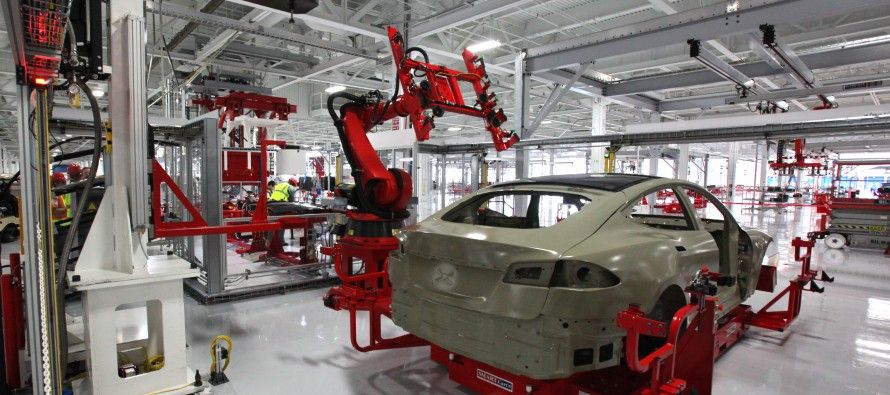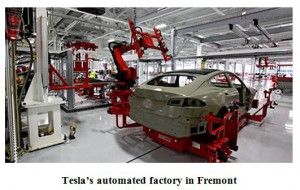CA manufacturing rises — a little

 California’s hard-hit manufacturing sector is coming back, although not as much as the rest of the country. The Great Recession sliced off 18.5 percent of state manufacturing jobs.
California’s hard-hit manufacturing sector is coming back, although not as much as the rest of the country. The Great Recession sliced off 18.5 percent of state manufacturing jobs.
After that, from 2011 to 2014, “manufacturing employment has hovered around 12.5 million,” reported the Sacramento Bee.
“There certainly are pockets of success,” Gino DiCaro told CalWatchdog.com; he’s vice president of communications at the California Manufacturers & Technology Association.
A big contributing factor, he said, was the sales tax exemption for purchasing manufacturing equipment passed by the Legislature and signed by Gov. Jerry Brown in 2013. “Until then, we were one of the few states that taxed it,” DiCaro said.
It’s too early to see just how much that tax cut will help manufacturing. But DiCaro cited figures that the state has a lot of catching up to do. Since Jan. 2010, California manufacturing has increased just 1 percent. That’s much less than the 7 percent for the United States as a whole — and a whopping 18 percent for Indiana, a Rust Belt state currently inundated by the record cold and massive blizzard hitting the Northeast.
Toyota’s website boasts it employs “4,500 people here at Toyota Motor Manufacturing, Indiana, Inc. (TMMI), and our local suppliers employ thousands more across Indiana. Our $4.1 billion investment in the state of Indiana gives us the capacity to build nearly 300,000 vehicles a year here, including the Sequoia full-size SUV, the Highlander midsize SUV and the Sienna minivan.”
Toyota shut its California NUMMI plant in Fremont in 2010. And last year it announced its U.S. headquarters was moving from Torrance to Texas, costing 3,000 jobs. However, those are office jobs, not manufacturing.
On the positive, the NUMMI plant now builds Teslas. But even there, Tesla chose Nevada over California to build batteries, albeit because California wouldn’t match Nevada’s $1.3 billion in tax breaks — effective subsidies paid by the rest of the state’s taxpayers.
DiCaro also pointed out that, in 2013, the Golden State enjoyed “only 1.5 percent of new or expanded facilities in the United States,” even though our population is 12 percent of the country.
Energy problem
DiCaro said a big problem with California is that manufacturing paid 70 percent higher electricity rates than the rest of the country for electricity before AB32, the Global Warming Solutions Act of 2006 began to be implemented in recent years.
Currently, he said, “overall energy rates are increasing” due to AB32’s implementation of the cap-and-trade program, which charges companies, such as electricity utilities, for greenhouse-gas emissions that are too high. Also aiding the energy-rate increase is a separate mandate that 33 percent of California electricity must come from renewables by 2020. In his Inaugural Address last month, Gov. Jerry Brown called for an even higher goal of 50 percent renewables by 2030.
The exact cost is unknown. As CalWatchdog.com reported, “Brown recently was rebuked by the Little Hoover Commission for failing to disclose to Californians how much the price tag will be for renewable power in California.”
DiCaro fingered a particular problem. California still is the home for venture capital that funds amazing startups. But when such companies succeed “and want to scale up big time, the overall high energy rates become a significant impediment for a large manufacturer.”
The good, the bad and the weather
DiCaro urged that the manufacturing picture in California has its positive points:
- A fantastic climate — unlike, say, Indiana;
- Great quality of life;
- An excellent university system that produces engineers and others needed by high-tech companies.
The bad points that need to be worked on:
- A high cost of living that has produced the country’s highest poverty rate;
- High electricity costs;
- Environmental quality permitting that can delay projects for years;
- The country’s highest workers’ compensation costs.
On the latter, Greg Jones, western bureau chief of the Work Comp Central news site, reported on Feb. 19, “A flurry of legislative activity next week is expected to present California lawmakers with questions about the state workers’ compensation system that are bigger than whether sports teams should be required to provide coverage for cheerleaders.”
The 2004 reforms signed into law by Gov. Arnold Schwarzenegger since have been eroded, again putting California at a disadvantage for other states.
Along with the 2013 sales tax cut for manufacturers, serious work comp reform could indicate the state at least is trying to move its business climate in the direction of its balmy weather climate.
John Seiler
John Seiler has been writing about California for 25 years. That includes 22 years as an editorial writer for the Orange County Register and two years for CalWatchDog.com, where he is managing editor. He attended the University of Michigan and graduated from Hillsdale College. He was a Russian linguist in U.S. Army military intelligence from 1978 to 1982. He was an editor and writer for Phillips Publishing Company from 1983 to 1986. He has written for Policy Review, Chronicles, LewRockwell.com, Flash Report and numerous other publications. His email: [email protected]
Related Articles
Sen. Lieu And The River Called Denial
Commentary MAY 19, 2011 By STEVEN GREENHUT California’s fiscal problems are only front-page national news thanks to the state’s structural
Feinstein drought bill heads for House merger
In the novel “A River Runs Through It,” later made into a movie, Norman Maclean wrote, “Eventually all things merge into
California cities facing growing pension costs in new year
SACRAMENTO – After two years of miniscule investment returns, the nation’s largest state pension fund – the California Public Employees’




